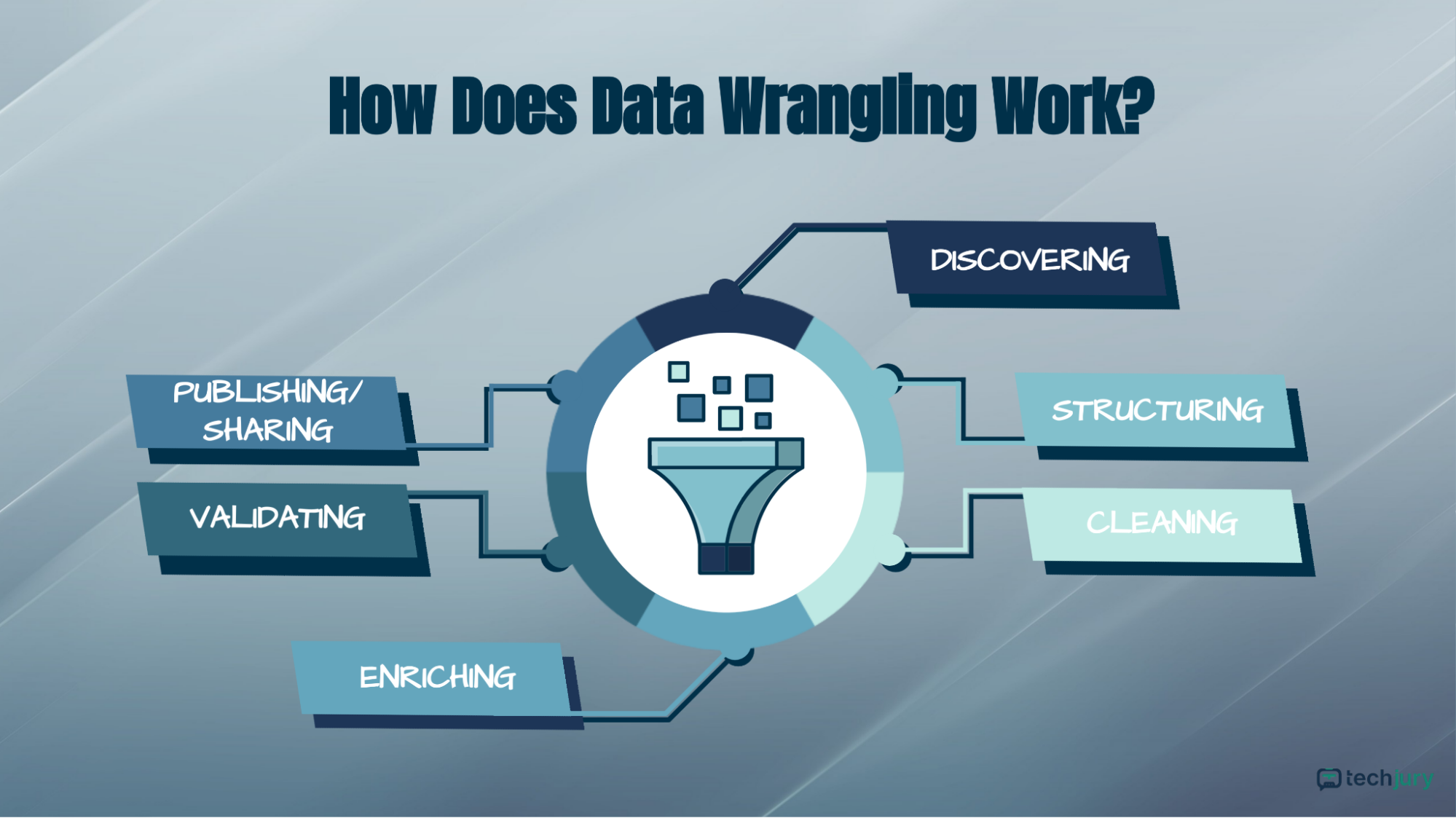

Updated · Jan 10, 2024
Updated · Aug 21, 2023
Muninder Adavelli is a core team member and Digital Growth Strategist at Techjury. With a strong bac... | See full bio
Florence is a dedicated wordsmith on a mission to make technology-related topics easy-to-understand.... | See full bio
Dealing with data can be daunting, especially since we generate 1.145 trillion megabytes daily. Fortunately, data wrangling is the best way to solve it.
Data wrangling is a process that turns raw data into a structured and readable format. It involves understanding, cleaning, structuring, and verifying data.
For every data management analysis and task, wrangling is vital. After all, over 95% of businesses face challenges with unstructured data management.
To learn more about this process, keep reading!
|
🔑 Key Takeaways
|
Data wrangling is a set of processes that turn unstructured data into an ideal format for analysis. It's also known as data remediation or munging.
The processes include exploring, transforming, and verifying raw data. As a result, you'll have a consistent, correct, and reliable format.
You can create insights and use them as business intelligence with the output. Any analysis will do well with data wrangling since it ensures the data is complete and reliable.
Continue reading to learn more about the steps included in the data wrangling process.
Data wrangling works through a combination of several processes. Below are the six essential steps and techniques involved in data wrangling:

Discovering data means familiarizing yourself with the data you will process. By doing so, you would know how you can use it.
In this process, you can discover any pattern or trend in the data or obvious issues you must fix later on.
This step is essential for every data-wrangling project since it will help you understand the next steps.
Data wrangling deals with and processes raw or unusable data. This means that the data can also be incomplete, appear in an inconsistent, or even wrong format.
Structuring means transforming the raw data into the form needed for analysis. The format will vary depending on the analytical model for interpretation.
Once the data is structured, you can find and remove the inherent errors. This process is what we call “cleaning”.
Since these errors will affect your analysis, you must remove or change them. The cleaning can happen in many ways, like deleting empty cells, removing wrong-valued rows, or aligning every input.
The primary goal of this step is to ensure that the database has no errors that can affect your analysis.
|
📝 Note: Some people compare data wrangling with data cleaning since the two are the same in a few aspects. However, the latter only refers to removing inaccurate data. This is only one part of the wrangling process since it also involves transforming the data into a more usable form. |
Enriching means determining if you have every data needed for the task. If not, it is needed to be enhanced by adding more data.
The new data can be acquired from other sets of data. In this step, you should know what additional data you must use.
Once you see enrichment as essential, you must repeat these steps until the data needed is completed.
This step means double-checking if the data is consistent enough and high-quality for your purpose.
In this process, you can see issues you must solve or determine if the data is ready for analysis.
You can achieve this step through several processes, but most can be automatic. A programming code can do this job for you most of the time.
After validating the data, you can publish and share it. This makes it available for others on your team to use and analyze.
The format of the final output will depend on its purpose. It usually comes as a written report or in an electronic format.
|
🎉 Fun Fact: Certain data wrangling and organizing projects can be achieved in Microsoft Excel or Google Sheets. |
Data wrangling accounts for almost 80% of data professionals' time. Many people wonder why they put so much time and effort into it.
When you look at it, the answer is simple: the output from this process is the basis of every analysis and plan. If the process isn't thorough, it can lead to failures, missed chances, and faulty solutions.
As such, better results can be attained if you allot more time, effort, and resources to data wrangling.
Here are more cases that show the importance of data wrangling:

Combining sources
The data wrangling process is necessary to combine several data sources into one database. With it, you can have reliable and comprehensive data for analysis and interpretation.
Cleaning irrelevant or blank data
This task is essential in data cleaning since it searches for gaps to remove or fill with data. It's also helpful in taking out unnecessary or irrelevant data.
Addressing inconsistencies
Data wrangling is essential to identify any anomalies in the data. It also explains these inconsistencies (if any) or deletion proceeds for better analysis.
Other than these use cases, data wrangling is also essential for companies. Here’s why:
Fraud detection
With data wrangling, anyone can detect any inconsistency or inaccurate data. By doing so, it can provide evidence of fraud that happened in a business or company.
|
💡Did You Know? Fraud can happen in any company, big or small. White-collar crimes cost the world billions of dollars every year. In 2022 alone, California lost $1.25 billion to fraud crimes. |
Data security protection
As data wrangling transforms raw data, it can support any information security essentials. It does the job by providing consistent and correct data from the raw one.
Accurate and consistent data output
Companies and businesses always need solutions and analysis. With this, data wrangling offers consistent and accurate data for every problem that must be solved.
Compliance with regulations
This process can help businesses follow industry standards. They can find solutions and systems relevant to the industry's regulations.
Analyze consumer behavior
Data wrangling offers a detailed output to analyze consumer behavior. With its result, businesses can take the necessary actions to improve performance based on this data.
Less time for data preparation
Data wrangling tools helps companies and businesses prepare and analyze data faster. As a result, they spend less time on data preparation.
Discover data trends
Data wrangling helps in creating analysis and insights into trends. You can interpret and predict trends based on reliable and structured data.
Recognize value
Companies and businesses can use data wrangling to see where they stand based on any raw data they have. Data wrangling lets them recognize the value and see if there's any improvement or progress. It will also help them set new goals to achieve.
|
👍 Helpful Article: Are you interested in data wrangling but don’t know where to start? Check out our recommendations for 8 tried and tested data-wrangling tools. |
Data wrangling involves complicated steps since it works on raw and unstructured data. Here are some challenges you'll face should you do a data-wrangling task:

Dealing with a massive volume of data to wrangle
These days, data wrangling involves massive amounts of data—or what we now call “Big Data.” With a high volume to process, this task becomes challenging.
For example, significant e-commerce sites like Amazon ship 1.6 million packages daily. With so many orders, they must process thousands of transactions every minute. In this case, they need an efficient data-wrangling solution to process data faster.
Processing unstructured data
Data comes in various forms, and most of them are raw and unstructured. Traditional databases are not suitable for handling this type of data.
For instance, customer reviews vary from one person to another. Some customers do bulleted reviews, while others review in one phrase or sentence.
In this case, a business needs advanced methods and tools to process valuable insights from unstructured data.
Evolution of formats and sources
Various data formats and sources have evolved over the years. These changes result in data inconsistencies. Moreover, the resources can have different structures.
For example, each platform differs in the format and structure of its data. You need to understand the design and layout of each platform. This way, you'll know how to process the data from them.
Adhering to security and privacy rules
Security and privacy are essential in every piece of data you wrangle.
This challenge usually arises when dealing with sensitive data. Some of them are personal information, medical histories, or financial records.
Besides these challenges, you must also understand data-wrangling techniques, steps, tools, and best practices.
Knowing all these is the best way to deal with the challenges of the task. This lets you have a smoother process and better output in less time.
The main difference between data mining and data wrangling is the steps involved. Data mining finds patterns and relationships in large data groups. On the other hand, data wrangling does more by turning raw data into useful ones.
Data wrangling in Excel is possible in several ways. If you want to do some cleaning, select the range you wish to process. Then, click the Data tab > Data Tools > Text to Columns. Afterward, follow the instructions using the Convert Text to Columns Wizard.
Python is the best language for data wrangling. Besides being efficient and versatile, it can host several open-source libraries supporting the data wrangling process. Python also includes debugging tools.
Your email address will not be published.
Updated · Jan 10, 2024
Updated · Jan 09, 2024
Updated · Jan 05, 2024
Updated · Jan 03, 2024




